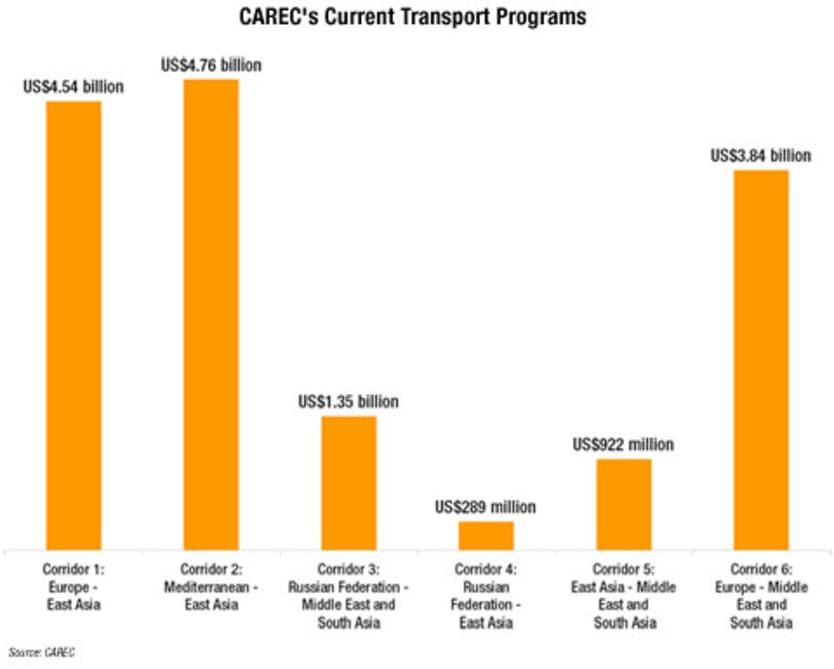
The aggressive expansion of China, re-emergence of Russia and the growth of Southeast Asian markets are compelling indications of the real demand for revitalizing ancient trade relations between Europe and Asia. This call for the renewal of old ties provides Central Asia, once a backyard of the Soviet Union, a unique opportunity to rebuild itself as a gateway to both continents and at the same time improve the standard of living in the region.
The Central Asia Regional Economic Cooperation plays a critical role in spearheading this endeavor. CAREC is a program that facilitates project-based cooperation in transport, trade, energy and other major sectors. It is a partnership between 10 countries (Afghanistan, Azerbaijan, the People’s Republic of China, Kazakhstan, the Kyrgyz Republic, Mongolia, Pakistan, Tajikistan, Turkmenistan, and Uzbekistan) and six multilateral institutions (Asian Development Bank, European Bank for Reconstruction and Development, International Monetary Fund, Islamic Development Bank, United Nations Development Program and World Bank). ADB acts as the program’s secretariat. Since 2001, the program has mobilized almost $17 billion worth of investments in energizing various sectors in the region. With reducing poverty through trade facilitation and job creation as its goals, CAREC is developing a seamless network of six corridors that will interconnect its landlocked countries and raise the region’s transport infrastructure to international standards by 2017.
Despite CAREC’s expected benefits, analysts are quick to take note of the issues and challenges that come with the program. Fragile local industries that have been relatively isolated in the past might not survive the competition that integration brings. Also, national governments might be reluctant to sign future cooperative agreements as they would have to reduce tariff and other trade revenues.
Nonetheless, the six-corridor program is currently being implemented. Its procurement activities are mainly handled by ADB and the World Bank, which both have transport expenditures of more than 20 percent of their aid in the last two years. Since 2007, Devex has recorded 126 projects and tenders that are related to the construction of the six corridors. Companies that are based both from inside and outside Central Asia are participants in the program. Some of them are the U.S.-based TERA International Group, Korean firm DOHWA Consulting Engineers, and Uzbekistan-based Rhythm Plus Consulting Co. Below is a summary of the program’s components.
Corridor 1: Europe - East Asia
With a current budget of $4.54 billion, Corridor 1 links the Russian Federation and China through infrastructure built in Kazakhstan and Kyrgyzstan. A notable component of this corridor is a road rehabilitation project in Kazakhstan, a country bordering northwestern China’s Xinjiang province. Xinjiang serves as a doorway for Eastern European goods into the Chinese and Southeast Asian markets. In total, Corridor 1 is comprised of 13,600 kilometers of roads and 12,000 of railways, one logistics center, and three airports.
Corridor 2: Mediterranean - East Asia
Corridor 2 connects East Asia to Mediterranean countries via Azerbaijan, where the Baku International Sea Trade Port is located. The sea port is crucial because it hosts most shipping operations that transport goods from China to Turkey. With China continuously implementing its “Go West” policy, trade activities will continue to take place along this corridor. Corridor 2 has a current budget of $4.76 billion and is comprised of 9,900 kilometers of roads and 9,700 kilometers of railways.
Corridor 3: Russian Federation - Middle East and South Asia
With an ongoing funding of $1.35 billion, Corridor 3 aims to bolster eastern Russia’s trade relations with the Middle East using Iran as a point of entry. This connection will benefit Central Asian countries where infrastructure is built to link the two regions. Road construction in countries like Kazakhstan and Tajikistan are some of the components of this corridor. Overall, Corridor 3 has 6,000 kilometers of roads and 4,800 kilometers of railways.
Corridor 4: Russian Federation - East Asia
Corridor 4 is strengthening the trade relations between Russia and China via Mongolia. Located in between these two large economies, CAREC is developing bus transport programs in Mongolia to ensure that the country becomes a viable economic intersection. With the smallest budget compared to the rest, Corridor 4 has $289 million at its disposal in constructing 2,400 kilometers of roads and 1,100 kilometers of railways.
Corridor 5: East Asia - Middle East and South Asia
With the second lowest budget of $922 million, Corridor 5 is improving Chinese trade relations with the Middle East and South Asia using Central Asia as a junction. The crucial component in this corridor is Afghanistan, which would ensure the smooth arrival of Chinese goods in Iran, Pakistan and possibly to the rest of the Middle East. In sum, Corridor 5 has 3,700 kilometers of roads and 2,000 kilometers of railways.
Corridor 6: Europe - Middle East and South Asia
Just like Corridor 3, this corridor attempts to take advantage of Russia’s growth by linking the country to the Middle East via Central Asia. If Corridor 3 focuses on Siberia or Eastern Russia, Corridor 6, with a budget of $3.84 billion, has its starting point in the western part of the country. Using Iran again as a gateway to the Middle East, western Russia will be able to move its goods by passing through a total of 10,600 kilometers of roads and 7,200 kilometers of railways located in Central Asian countries.




